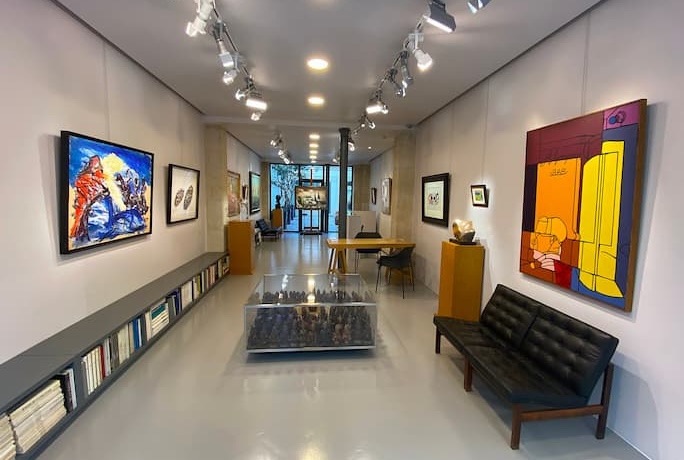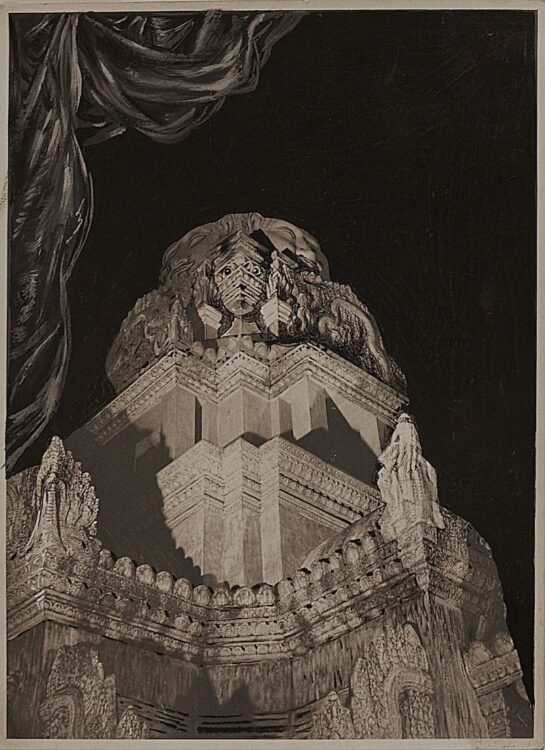Director: Vincent Amiaux
13 rue des Saints-Pères, 75006 Paris
Phone: +33 1 40 15 00 15
E-mail: galerie.des.modernes@orange.fr
www.galeriedesmodernes.art

Since its creation in 1998 in Paris, Galerie des Modernes has been run by one of its founders, Vincent Amiaux.
The gallery initially specialized in the French masters of the 1910s to 1940s, before extending its interest to the whole of the 20th century. True to its choices, the gallery presents paintings, drawings and sculptures by artists linked to the major movements in the history of Modern Art.
The gallery is regularly asked to lend to prestigious museums and institutions in France and abroad (MNAM, Centre Georges Pompidou, Paris, Musée d'Orsay, Tate Modern, London, MOMA, New York, Narodni Gallery, Prague...).
Galerie des Modernes is a member of Carré Rive Gauche and the Comité Professionnel des Galeries d'Art (CPGA).
Salvador DALI
(1904-1989)
Apparition d'une Infante de Velasquez au Sommet d'un Temple Hindou or Mystification de "Las Meninas"
Circa 1940-1941
Gouache and India ink on black and white photograph
23,4 x 17 cm
© Galerie des Modernes, Paris
Provenance
- Collection John Peter Moore (London, 1919 - Cadaqués, 2005)
- Former collection of the Perrot-Moore Art Center, Cadaqués
Certificate of authenticity from Messieurs Robert et Nicolas Descharnes dated June 27, 2003
Exhibitions
- Salvador Dali, Bilder, Zeichnungen, Ojekte, eine Ausstellung des Museu Perrot-Moore, Cadaques, Vienne, Palais Auersperrg, March - April 1982, no. 45, reproduced in the catalogue
- Salvador Dali, Bilder, Zeichnungen, Ojekte, eine Ausstellung des Museu Perrot-Moore, Cadaques, Munich, May - June 1982, presented under no. 45, reproduced in the catalogue
- Salvador Dali, Huiles, Dessins, Sculptures. La collection Salvador Dali du Musée Perrot-Moore, Cadaques, Perpignan, Palais des Rois de Majorque, Août - Septembre 1982, no. 45, reproduced in the catalogue
- Salvador Dali, Bilder, Zeichnungen, Ojekte, eine Ausstellung des Museu Perrot-Moore, Cadaques, Zurich, SeedammKulturzentrum, December 5 1982 - January 30 1983, no. 45, reproduced in the catalogue
- Salvador Dali, Huiles, Dessins, Sculptures. La collection Salvador Dali du Musée Perrot-Moore, Cadaques, Toulouse, Réfectoire des Jacobins, November 1983 - January 1984, reproduced in the catalogue
- Salvador Dali in Argentina, Buenos Aires, Museo National de Arte Decorativo, June - July 1986, reproduced in the catalogue
- Dali no Brasil, Sao Paulo, Museo de Arte Moderna, September 4 - October 5 1986, reproduced in the catalogue
- El arte del dibujo. El dibujo en el arte, Bilbao, Fondation B.B.K., August 22 - October 8, 2005, described in catalogue, ed. Fundacion Bilbao Bizkaia Kutxa Fundazioa, 2005, p. 68 and reproduced in color p. 69
- Dali, Zaragoza, Centro de Exposiciones y Congresos Ibericaja, San Ignacio de Loyola, February 23 - April 16, 2006, reproduced in color in the catalogue p. 62 under no. D 10
- Dali, Paris, Centre Georges Pompidou, Musée National d'Art Moderne, November 21, 2012 - March 25, 2013, reproduced in color in the catalogue, ed. du Centre Pompidou, Paris, 2012, p. 310
- Dali Eureka, Céret, Musée d'art moderne de Céret, June 24 - October 1, 2017, presented under no. 172, described in the catalogue, Somogy Éd. d'Art, Paris, 2017, p. 156 and reproduced in color on p. 157
- Surréalisme et Littérature, Espace Culturel Départemental, Aix-en-Provence, July 7 - October 3, 2021, reproduced in color in the catalogue, 2021, p. 84
Literature
The Secret life of Salvador Dali by Salvador Dali, Dial Press, New York, 1942 reproduced on plate XI “The Great Paranoiac”, between p. 278 and p. 279
To the question “What's new in painting? “Dali replied, “Velázquez ! ”
Apparition D'une Infante De Velasquez Au Sommet D'un Temple Hindou, painted in New York circa 1940-1941, reinterprets the emblematic figure of Princess Margarita, daughter of King Philip IV of Spain, of whom Velasquez had painted several official portraits, making the Infanta one of the most iconic images in Spanish Baroque painting.
With his characteristic eclecticism and fantasy, Dali proposes a strange association. On a black-and-white photograph of a Hindu temple, Dali conjures up the Infanta in gouache and ink. Like an “anamorphic” work, Princess Margarita is entirely made up and structured of architectural elements from the Temple. A “trompe-l'œil” skilfully imagined by the artist, thanks to a play of transparencies and heterogeneous superimpositions that create volumes and nuances
This unusual work illustrates Surrealism through the dreamlike juxtaposition of this famous court portrait with an apparently unrelated non-Western architecture. Finally, the bold choice of the Hindu Temple testifies to Dali's interest in religious and mystical themes. In his phantasmagorical imagination, Margarita was not only a princess, but under his brushes she became a Saint who he elevated to the rank of immortal divinity, as Velasquez's painting could be for him.

